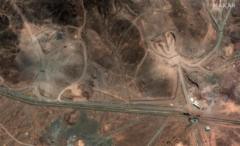Has Iran's Nuclear Program Suffered Severe Damage?

Understanding the Impact of US Strikes on Iran's Nuclear Facilities
The geopolitical landscape surrounding Iran's nuclear capabilities is fraught with tension, conflicting narratives, and strategic military actions. Recently, the head of the CIA claimed that U.S. strikes have "severely damaged" Iran's nuclear facilities, a statement that starkly contrasts a leaked Pentagon report suggesting minimal impact. This article explores the ramifications of these military actions, the differing assessments from various intelligence agencies, and the broader implications for U.S.-Iran relations and global security.
The Context of U.S.-Iran Relations
For decades, the relationship between the United States and Iran has been characterized by suspicion and hostility. Following the 1979 Iranian Revolution, diplomatic ties were severed, leading to a series of sanctions and military confrontations. The core of the conflict revolves around Iran's nuclear ambitions, which the U.S. and its allies fear may lead to the development of nuclear weapons. In contrast, Iran has consistently asserted that its nuclear program is intended solely for peaceful purposes, such as energy production.
Recent Developments: U.S. Military Operations
On a significant day for U.S. military strategy, approximately 125 aircraft were deployed in a coordinated operation targeting three main Iranian nuclear facilities: Natanz, Fordo, and Esfahan. The U.S. military's objectives were clear: to disrupt and damage Iran's nuclear capabilities significantly. Reports indicate that key infrastructure at these sites was destroyed, leading to claims from U.S. officials that Iran's nuclear program has been set back by years.
Contrasting Assessments: CIA vs. Pentagon Intelligence
John Ratcliffe, the Director of the CIA, asserted that the strikes had resulted in substantial damage, which could take years for Iran to recover from. This statement was met with skepticism due to a leaked preliminary assessment from the Pentagon's Defense Intelligence Agency, which suggested that the damage inflicted would only delay Iran's nuclear ambitions by "a few months." This disparity raises questions about the reliability of intelligence assessments and the motivations behind them.
- CIA's Position: Claims severe damage to key facilities.
- Pentagon's Position: Suggests limited impact on the nuclear program.
- Presidential Response: President Trump maintains that the strikes were an "obliteration" of Iran's capabilities.
The Implications of Military Action
The implications of these military actions extend beyond immediate damage to infrastructure. They influence diplomatic relations, regional stability, and international perceptions of both U.S. authority and Iran's intentions. The following points outline the potential consequences:
- Diplomatic Strain: The contrasting narratives from U.S. intelligence agencies may complicate diplomatic negotiations with Iran. Trust between the nations is already tenuous, and conflicting assessments could hinder future talks aimed at curbing Iran's nuclear ambitions.
- Regional Tensions: The strikes may escalate tensions in the Middle East, prompting Iran to respond either through direct military action or by supporting proxy groups in the region. This could destabilize neighboring countries and lead to broader conflicts.
- Global Security Concerns: As nations assess the situation, the possibility of an arms race in the Middle East could increase. Countries in the region may feel compelled to enhance their military capabilities in response to perceived threats from both Iran and the U.S.
Expert Opinions and Analysis
As the situation evolves, various experts have weighed in on the potential ramifications of the U.S. strikes. Tulsi Gabbard, the Director of National Intelligence, echoed the CIA's assessment, emphasizing that rebuilding the damaged facilities would take substantial time and resources. Conversely, Iranian officials have downplayed the extent of the damage, suggesting that operations could continue with minimal disruptions.
Mehdi Mohammadi, an adviser to the Iranian parliament, claimed that "no irreversible damage" was sustained at Fordo, highlighting a persistent narrative within Iran that its nuclear program remains intact and capable of continuing its activities.
The Role of Satellite Imagery
New satellite images provide critical insights into the aftermath of the strikes. They show craters and other signs of damage around key sites like Fordo and Isfahan. However, the extent of damage to deeply buried facilities remains uncertain. Analysts suggest that while surface-level damage may be visible, much of Iran's nuclear capabilities could still be operational underground.
International Reactions and Future Negotiations
Global reactions to the U.S. strikes have varied, with allies expressing support for U.S. actions while others, including Russia and China, have criticized the military intervention. The potential for renewed diplomatic negotiations looms, with President Trump indicating he may seek a commitment from Iran to abandon its nuclear ambitions in upcoming talks.
However, the effectiveness of such negotiations remains in question. Iran has not confirmed any willingness to engage, and skepticism persists regarding the U.S. intentions and the credibility of its assessments.
Conclusion: Navigating a Complex Landscape
The recent U.S. military strikes against Iran's nuclear facilities represent a pivotal moment in the ongoing conflict between the two nations. With conflicting intelligence assessments, differing expert opinions, and the potential for escalating tensions, the path forward remains fraught with uncertainty. As the international community watches closely, the challenge lies in balancing military strategy with diplomatic efforts to ensure regional stability and prevent the proliferation of nuclear weapons.
FAQs
What were the U.S. strikes on Iran's nuclear facilities intended to achieve?
The U.S. strikes aimed to disrupt and damage key Iranian nuclear facilities, thereby delaying Iran's potential development of nuclear weapons.
Why are there conflicting reports about the impact of the strikes?
Conflicting reports arise from different intelligence agencies' assessments, which can vary based on their methodologies, sources, and areas of expertise.
How might Iran respond to the U.S. strikes?
Iran may retaliate through military action, support for proxy groups, or by continuing its nuclear program despite the damage inflicted by the strikes.
As the situation evolves, how will global powers navigate the complex dynamics of U.S.-Iran relations? #IranNuclear #USStrikes #Geopolitics
Published: 2025-06-26 00:03:04 | Category: wales



